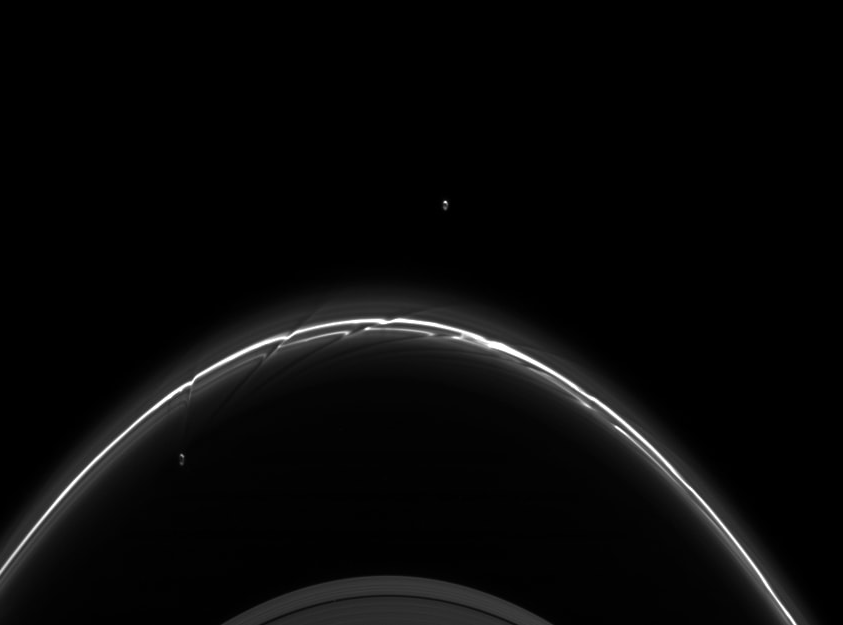The centaur Chariklo has two dense rings orbiting it. In attempting to explain their survival astronomers have proposed a yet-to-be-detected satellite, which they say may be keeping the rings in line.
Saturn’s rings have been known for almost four centuries, but in the last 50 years we have learned they are only the most dramatic examples of a common phenomenon. The Voyager probes revealed smaller ring systems around the other three gas giants. Between the orbits of Jupiter and Neptune, the bookends of the gas giants are smaller objects known as centaurs.
In 2013, the largest of these, Chariklo, briefly blocked the light of a star (known as an occultation). The star winked out to Earthly observers when Chariklo occulted it, but it also temporarily dimmed four other times, twice each before and afterwards. These dips revealed Chariklo’s own pair of rings, with orbits either side of 400 kilometers (240 miles) from the planet’s core.
From the start there was puzzlement as to how an object with so little mass – Chariklo is only 250 kilometers (150 miles) in diameter and thought to be primarily made of ice – could hold onto rings. Since then, reanalysis of what were first thought to be rings around fellow centaur Chiron indicated rings could be common, without explaining them, before we learned Chiron’s rings are probably an evolving lumpy disk.
Adding to the mystery, Chariklo’s rings are outside the centaur’s Roche limit, unless their density is much lower than that of Chariklo itself. Outside the Roche limit, rings should rapidly combine into moons.
Subsequent occultations have confirmed the rings’ existence and shown the inner one blocks 10 times as much light as its companion, leaving astronomers to model what is going on.

The moons Pandora and Prometheus and Saturn’s F ring. These two moons, around 80 kilometers (50 miles) wide, keep the F ring, which would otherwise be too far out to survive, in line. It was thought something similar was happening with Chariklo, but only one moon may be required.
The Planetary Science Institute’s Dr Amanda Sickafoose is one of those tackling the problem. “Planetary rings will naturally spread or disperse over time. Chariklo exhibits two thin rings, a few kilometers in width,” she said in a statement. In order for the rings to stay 7 and 3 kilometers (4 and 2 miles) wide, there needs to be “a mechanism to confine the material and prevent it from dispersing,” she added.
Sickafoose and co-author have shown that without such a mechanism the rings increase linearly in size with time, contradicting the dense, narrow bands indicated by the fairly brief drops in brightness. Unless we happened to see Chariklo almost immediately after the rings formed, something must be keeping the rings tight.
The same modeling shows that a suitably positioned satellite would do this; one about 3 kilometers (2 miles) wide and weighing a few tens of billions of tons would do the trick. We couldn’t see such an object at this distance unless it happened to be perfectly positioned to also block out the star back in 2013.

Simulated rings around Chariklo from this research, with an approximate 3-kilometer (2-mile) radius satellite in a 6:5 mean-motion-resonance, producing rings similar to those we have observed. Ring particles are shown in white.
Previously it was thought two shepherding moons might be required.
Sickafoose noted, “We think that the ring particles are primarily made of water ice, like those at the giant planets. We do not know the exact characteristics, such as how ‘hard’ or ‘soft’ the ring particles are when they collide, or the particle-size distribution.” Rings made of hard particles would be maintained indefinitely by the proposed moon, but outside the Roche limit soft particles would be much more likely to become moons themselves.
An alternative explanation is a gravitational anomaly on Chariklo’s surface, and a rotation rate that allows the force of this anomaly to keep the rings in line.
Although Sickafoose described the physics of the two scenarios as similar, such a mass concentration on the surface appears less in keeping with what we know about minor planets. On the other hand, it is far easier to imagine that an earlier ring turned into a moon, and then kept the remaining moons stable, something that is thought to explain Saturn’s F ring, maintained by the small moons Pandora and Prometheus.
Although the idea of Chariklo having a moon may appear to resolve the mystery, Sickafoose’s recent re-evaluation of Chiron’s rings suggests we shouldn’t get too confident without more observations. If the two centaurs turn out to have quite different surrounds it will open up even more questions, such as which provides the better analog for Haumea, or Quaoar, and how many other arrangements exist.
The study is published open access in The Planetary Science Journal.
Source Link: Chariklo’s Strange Ring System Might Be The Product Of A Shepherding Moon